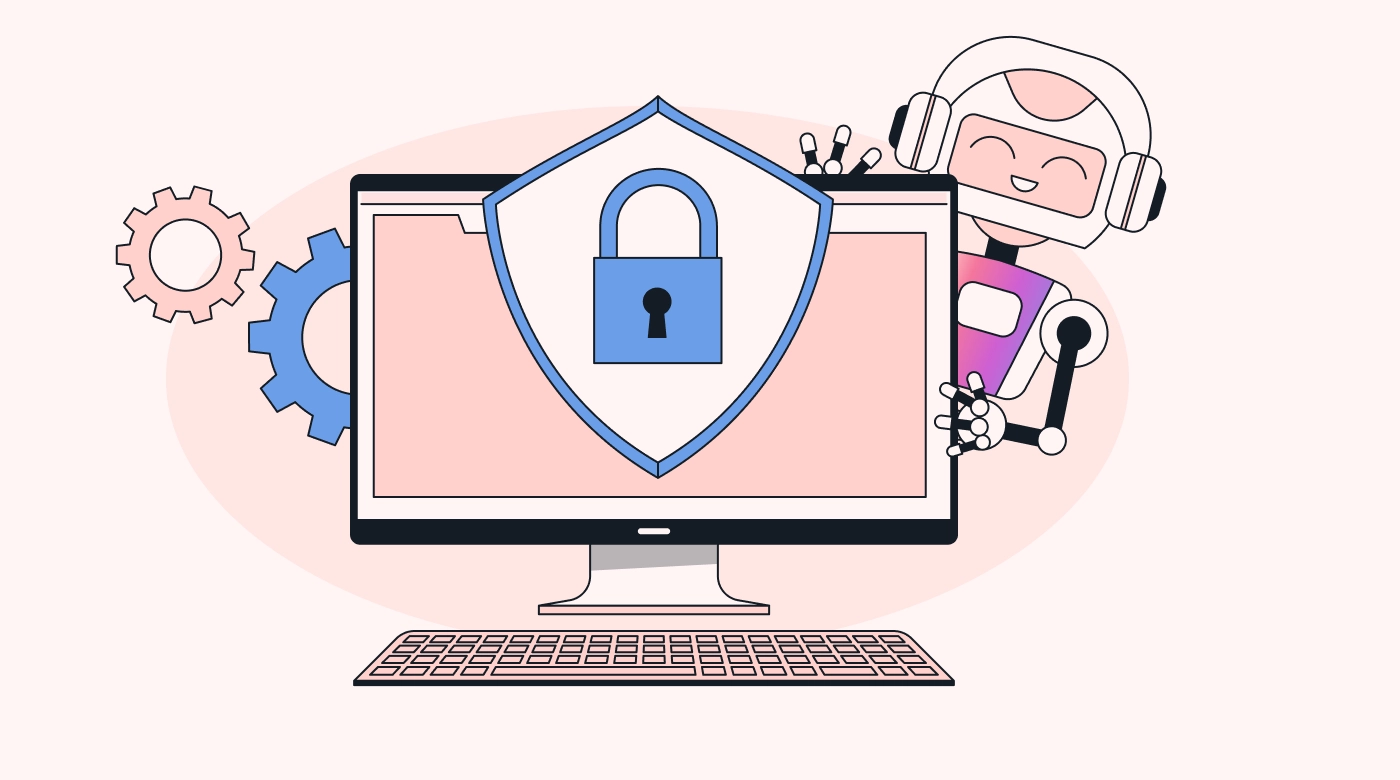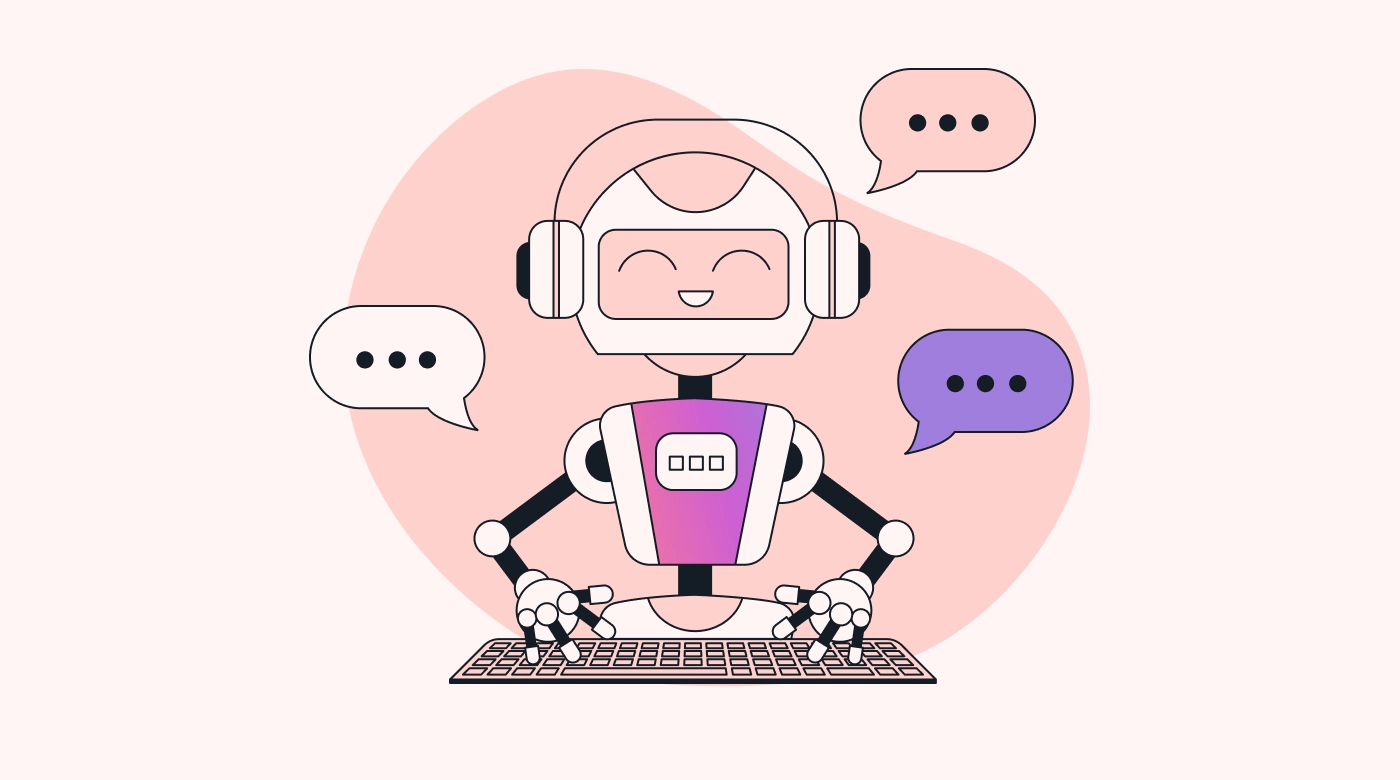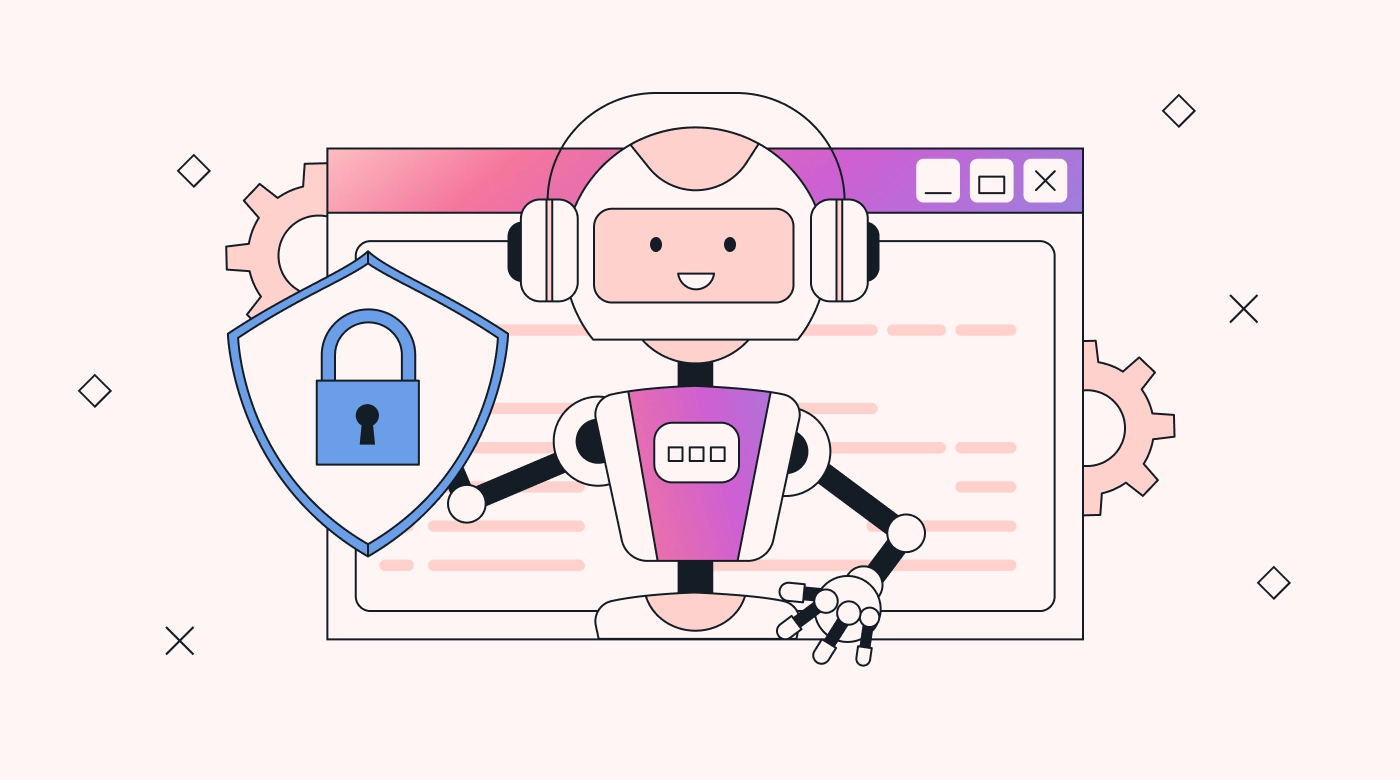Introduction
AI in the workplace is here to stay, whether you like it or not. In fact, 1 in 4 people are already using AI in their jobs to boost productivity and save time.
But if you don’t know how to use AI for your work, you risk missing out on the opportunities it offers and bogging yourself down with fancy AI tools that don’t actually impact your productivity.
In this article, we weigh the pros and cons of AI in the workplace and show you how to get the most out of it so you can level up efficiency in your business.
What does artificial intelligence software do?
Artificial intelligence (AI) software acts as an assistant, taking on manual tasks so you have more time for “human” work like generating ideas, collaborating, strategizing, and creating. It can handle routine work for you, analyze data to help you make decisions, and even “chat” with customers using natural language processing (NLP).
There are several different types of AI, and it’s worth knowing the distinction between them. Take traditional AI and generative AI, for example. Traditional AI is meant to perform specific tasks and make decisions or predictions based on historical data. Generative AI, on the other hand, uses data to create new content.
What are the disadvantages of AI in the workplace?
If you’ve turned on the news or been anywhere online in the past two years, then you’ve definitely seen someone talk about the dangers of AI. Whether it’s being accused of stealing people’s jobs or reading people’s minds, AI has been painted as something to fear.
Here are just some of the perceived risks of AI in the workplace — and the reality:
AI will take over people’s jobs
Many worry that AI will take over their jobs completely, making them unemployed. But, in reality, AI can handle repetitive tasks, allowing you to focus on more creative and strategic work.
So, turn this fear into an opportunity by learning new hard skills and adapting to work alongside AI.
Just think of how AI impacts customer service. Sixty-four percent of business owners believe that AI will continue to improve customer relationships, and 60% anticipate that it will drive sales growth.
And forget spending entire calls typing up notes. AI can automatically transcribe calls while picking up on customer sentiment and providing real-time suggestions and solutions. It can even spot upselling opportunities.
Privacy will be at risk
Concerns abound, claiming that AI might invade privacy by collecting too much personal data. In fact, 45% of people in the US are concerned about their information being exposed, breached, or exploited.
The reality is that responsible AI use involves strict data privacy regulations and ethical guidelines. So, consider this an opportunity to advocate for transparent data practices and make sure your own company follows best practices.
Pro tip: With AI working as your partner in data privacy, your marketing team can use anonymized data to create targeted campaigns without ever compromising customer privacy.

We’ll become completely dependent on technology
Some worry about relying too much on AI, claiming it could cause problems if it fails or that our dependence on it will negatively affect human intelligence.
However, using AI with human oversight can actually improve the former’s reliability. This is a chance to create backup plans and boost your tech skills and critical thinking.
Rather than thinking of AI as a replacement for human skills, think of it as an assistant that helps people think and work smarter, not less.
Many business executives already think of AI in this way, with 53% estimating that AI will boost their organization’s productivity by 10-30% until at least 2027.
Embracing AI at work can lead to new opportunities for innovation and efficiency. By understanding and managing the risks, you can use it to enhance your role and streamline business processes.
10 key opportunities to leverage AI in the workplace
From streamlining tasks to boosting productivity, here are 10 opportunities AI offers to make your work life easier and more efficient:
1. Automate task management
AI can handle routine tasks like task tracking and management, letting employees focus on more important work. AI-driven task management tools efficiently assign, track, and manage the flow of work to keep staff and projects on schedule.
By prioritizing based on deadlines and sending timely reminders to make sure these deadlines are met, they can reduce human error.
AI-driven smart calendars reschedule tasks automatically when conflicts arise to maintain a smooth workflow without the need for manual rescheduling.
A small marketing firm using AI smart calendars, for instance, can automate their task assignment, maintain real-time status updates, and meet their deadlines more easily as they focus on their creative tasks.
2. Self-schedule meetings
AI can automate meeting and appointment scheduling, making it easier to find a time that works for all attendees. It checks availability and preferences, integrating with other tools to make sure all necessary information is ready. This cuts down on back-and-forth emails, saving time and reducing scheduling conflicts and errors.
Self-scheduling calendars are especially helpful for remote teams, as they help staff and stakeholders find optimal meeting times automatically, even across time zones.
3. Make better decisions
Let AI analyze large datasets to uncover insights and hidden trends you might have otherwise missed. Use it to spot patterns, predict outcomes, and get helpful recommendations so that you can make informed decisions faster and reduce risks.
Improve the accuracy and reliability of your business forecasts and plan for different scenarios by simulating various strategies.
For example, a retail business using AI to analyze sales data can spot trends and predict customer preferences in advance. This helps them make informed decisions on inventory, marketing strategies, and staffing, ultimately boosting sales and reducing wastage in a way that wouldn’t have been possible without the help of AI to analyze such large datasets.
4. Centralize communication
Use AI to bring together your emails, instant messages, video calls, and project tools in one place. Prioritize important messages and filter out spam. Get easy-to-read summaries of key conversations to keep you in the loop and help you access all the information you need quickly without having to search for it.
With your communication channels all in one place, you’ll spend significantly less time switching between apps. Make it easy for your team to get help when and where they need it so that they can stay on task without distraction.
5. Improve the customer experience
Use AI-powered chatbots and virtual assistants to provide instant responses to simple customer questions that might normally bog down your phone lines.
Handle a high volume of customer requests simultaneously without breaking a sweat. Then, use in-call tools in human interactions to analyze interactions in real time so that you can spot issues, report on customer sentiment, and provide in-call solutions to help customers.
No more keeping people on hold or limiting contact hours. Boost customer satisfaction by offering timely support from highly trained customer service reps. 24/7 chat support means customers are helped exactly when they need it.

By using AI chatbots, you can free up your employees to focus on more complex and nuanced queries that require a human touch, saving you staffing costs.
6. Enhance recruitment processes
Tools like LinkedIn Talent Insights and HireVue are changing the way businesses hire in 2024.
Did you know that you can use AI to automate resume screening and match job candidates to roles and job descriptions? You can even conduct initial job interviews using chatbots and video tools to save time.
Plus, you can analyze past hiring data to predict which candidates will succeed and streamline your recruitment process, cutting down on time-to-hire.
By reducing the manual load of the initial screening process, you can focus more on personal interactions with top candidates while AI handles the initial stages. Make smarter hiring decisions faster and build a stronger team.
7. Personalize employee training
Want to invest more in upskilling your staff with targeted professional development?
With AI, you can tailor training programs to each employee’s learning style and performance, all in one platform. Tools like Coursera use AI to personalize employees’ learning journeys. You can track their progress and provide feedback, plus make sure everyone gets the training they need at their own pace.
Create a culture of continuous learning and improvement with AI-driven training, and watch as job satisfaction goes up.
8. Optimize resource allocation
Use AI’s machine learning capabilities to analyze your data and recommend the best way to distribute tasks and resources. With smart scheduling that factors in your staff's availability and skills, you can assign the right team members to the right tasks at the right times, reducing wasted time and improving your project outcomes.
Think of this as automated speed-dating — but instead of matching couples, AI matches each task with the ideal person to complete it, making the most of your team’s strengths and skills.
9. Boost cybersecurity
Despite the fear that AI is a cybersecurity threat, AI is actually an incredible partner in protecting your data. Use it to quickly and accurately detect and respond to threats.
Analyze data to spot unusual patterns and potential breaches, automating responses to mitigate threats and prevent data loss.

Plus, protect sensitive information and maintain trust with your clients through real-time monitoring.
Tools like Darktrace and CrowdStrike use AI to detect and respond to threats in real time, keeping business data secure.
10. Streamline project planning
Use AI to automate project planning tasks, like creating timelines and allocating resources. Identify potential risks and track progress in real time.
You can receive updates and alerts as milestones approach and address issues before they become problems to keep projects on track.
Improve project outcomes with proactive management and timely adjustments, such as automatically reassigning a task when the initial assignee becomes unavailable.
4 pro tips for getting started with AI
Now that you’re familiar with the key AI opportunities, let's focus on actionable steps. Here are some pro tips to help you get started with AI right now:
1. Identify manual, repetitive tasks
Rather than working on hypotheticals, test out AI on real-world tasks in your business:
- List the administrative tasks that slow you down every day, like assigning projects, taking meeting notes, and scheduling recurring meetings.
- Check in with your team to see which tasks they would automate if they could.
2. Match solutions to your needs
Don’t let the number of available choices become overwhelming. Instead:
- Start by automating the tasks you identified above.
- Then, choose two or three key problem areas and source tools that best suit those specific needs.
3. Try an all-in-one solution
If you’re still unsure what to automate first, try out a tool that manages your entire workday.
- At a bare minimum, you should be looking for a tool that can manage your workload, schedule your meetings, and reassign tasks based on any changes as they happen.
- That same tool should also offer native integrations with key business apps like Google Calendar and iCloud Calendar as well as integrations with third-party apps through a tool like Zapier.
4. Be careful with sensitive information
AI will use any input as training data. So, if your employees are uploading sensitive personal data to LLMs, then the LLM provider might train on that data — and that’s not something you want. So:
- Make sure your AI policy protects your employees’ proprietary information.
- Maintain sensitive data only for as long as is necessary.
Think of AI as a way to streamline and automate your entire workflow, not just fill gaps.
Unleash the power of AI with Motion
Embracing AI in the workplace is no longer a choice but a necessity to stay competitive and efficient. With it, you can streamline your workflows, automate repetitive tasks, and focus on what truly matters: your creativity and strategic initiatives.
Motion is designed to help you harness the full potential of AI, making your workday more productive and less stressful.
Start using AI to transform your business operations. Try Motion for free today and elevate your productivity to new heights.

Haylee is a versatile writer with ten years of experience. With a background in marketing and writing for large SaaS companies, Haylee brings her passion for the written word to diverse projects ranging from blog posts and ebooks to direct marketing campaigns.




